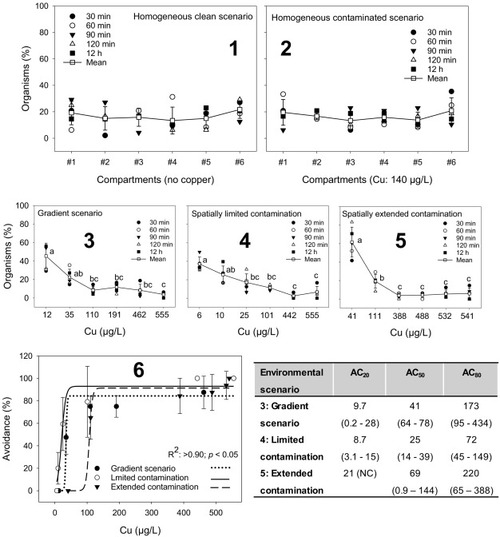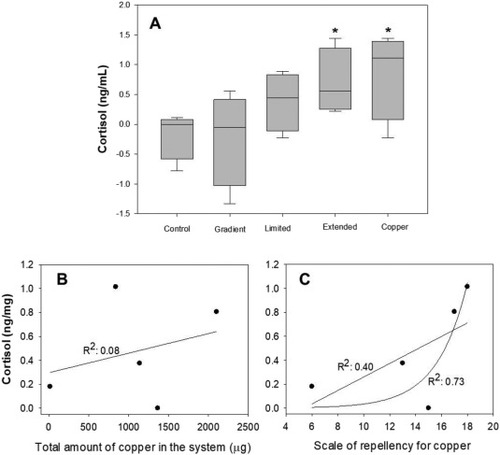- Title
-
Are habitable clean areas in heterogeneously contaminated landscapes functioning as escape zones for fish populations to alleviate stress?
- Authors
- Araújo, C.V.M., Sendra, M., Pontes, J.R.S., Trombini, C., Blasco, J.
- Source
- Full text @ Sci. Total Environ.
|
Multi-compartmented non-forced exposure system (total length: 300 cm; total volume: 6 L) used in the avoidance tests and the different contamination scenarios tested. Compartments: A: 28 × 4 cm (length x width), B: 1 L, C: 8 cm, D: 2.2 cm (diameter), and E: 50 cm. Tweezers (F) were used to introduce the plasticine plugs (black circles) and to close the connections between the compartments. |
|
Spatial distribution (%) at different time periods (30, 60, 90 and 120 min and 12 h and a mean of all the exposure times) of fish populations in the multi-compartmented exposure system in tests with five different scenarios: homogenously clean scenario (1), homogeneously contaminated scenario (2), contamination gradient scenario (3), spatially limited contamination scenario (4) and spatially extended contamination scenario (5). Different letters indicate statistically significant differences in the mean values (Bonferroni post-hoc test; p < 0.05). The mean (for 12 h exposure) avoidance (%) and sigmoidal models for the three heterogeneous contamination scenarios are also presented. The table presents the values of AC20, AC50 and AC80 (μg/L) of copper for zebrafish exposed for 12 h to the three heterogeneous copper contamination scenarios. NC: not calculated. PHENOTYPE:
|
|
Boxplot of the levels of whole-body cortisol of zebrafish populations (n = 4) exposed to different copper contamination scenarios (A – see details of scenarios in Material and Methods). The asterisks represent statistically significant differences in the cortisol levels of the treatments (populations in different environmental scenarios) compared to the control population according to the unpaired t-test with Welch correction. The relationship between stress (cortisol levels) and the copper contamination considering the total amount of copper in the system (B – sum of the copper detected in all the compartments of the system) and the scale of the repellency of copper based on the probability of triggering avoidance (C – here ACs values were taken as the reference – see Materials and Methods for details). PHENOTYPE:
|



